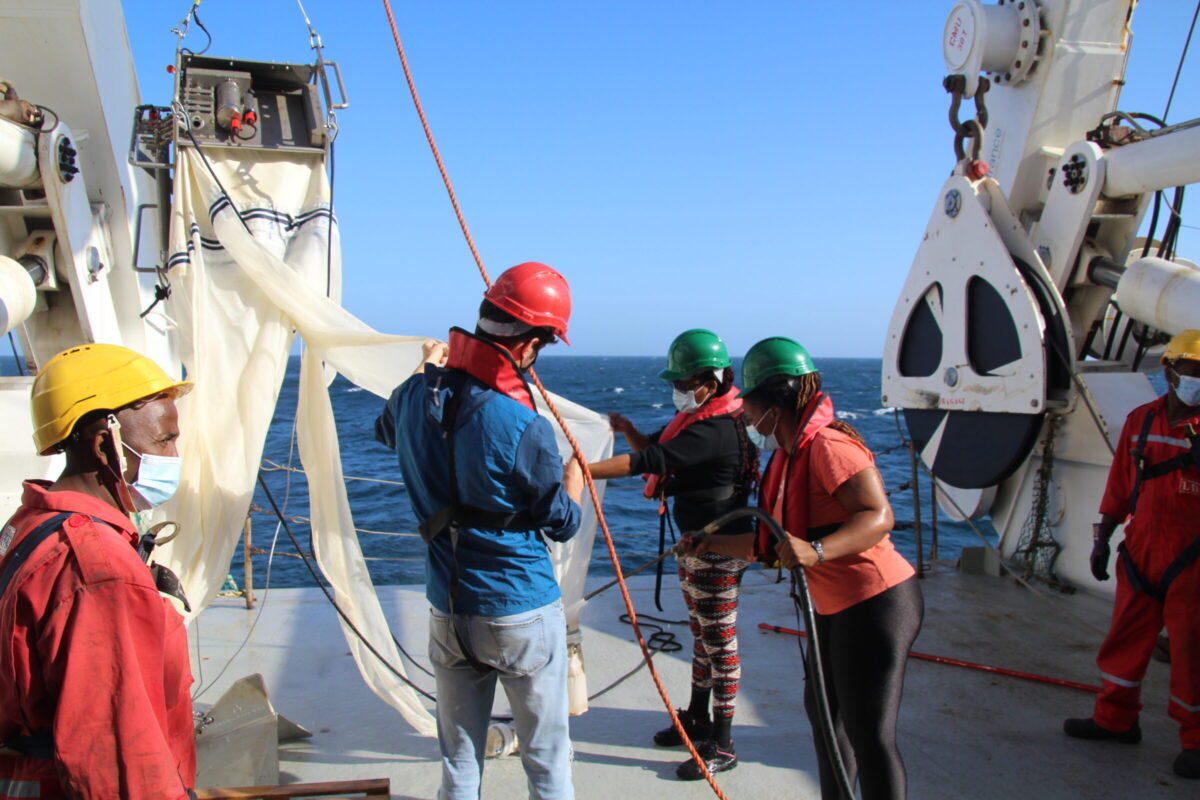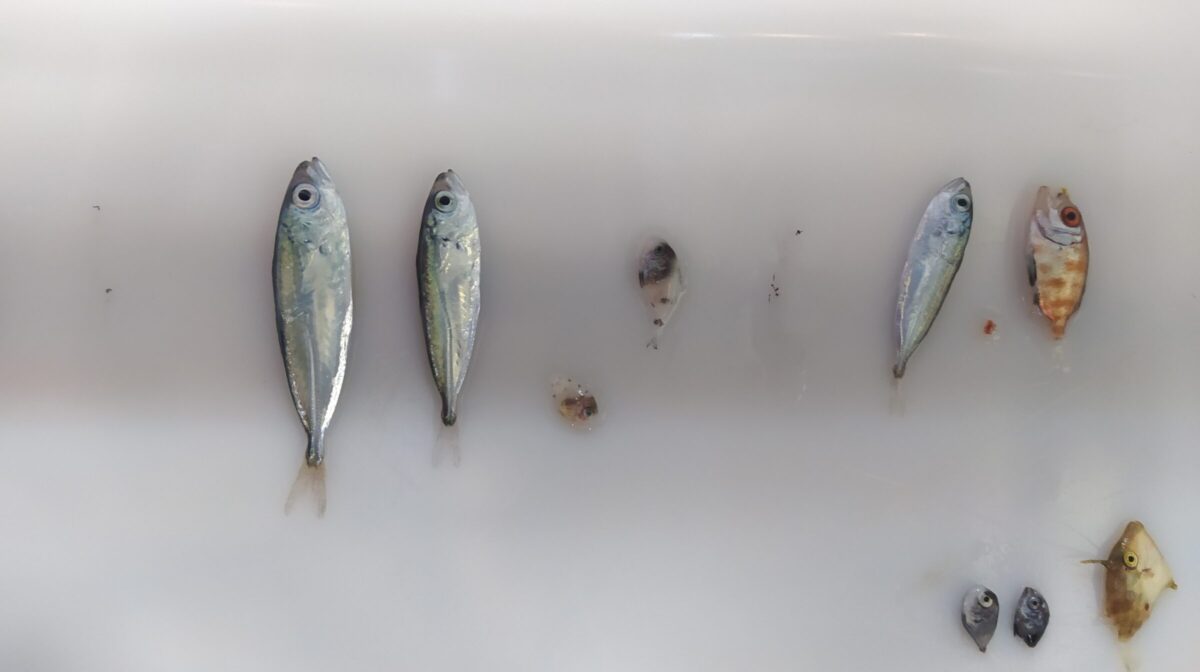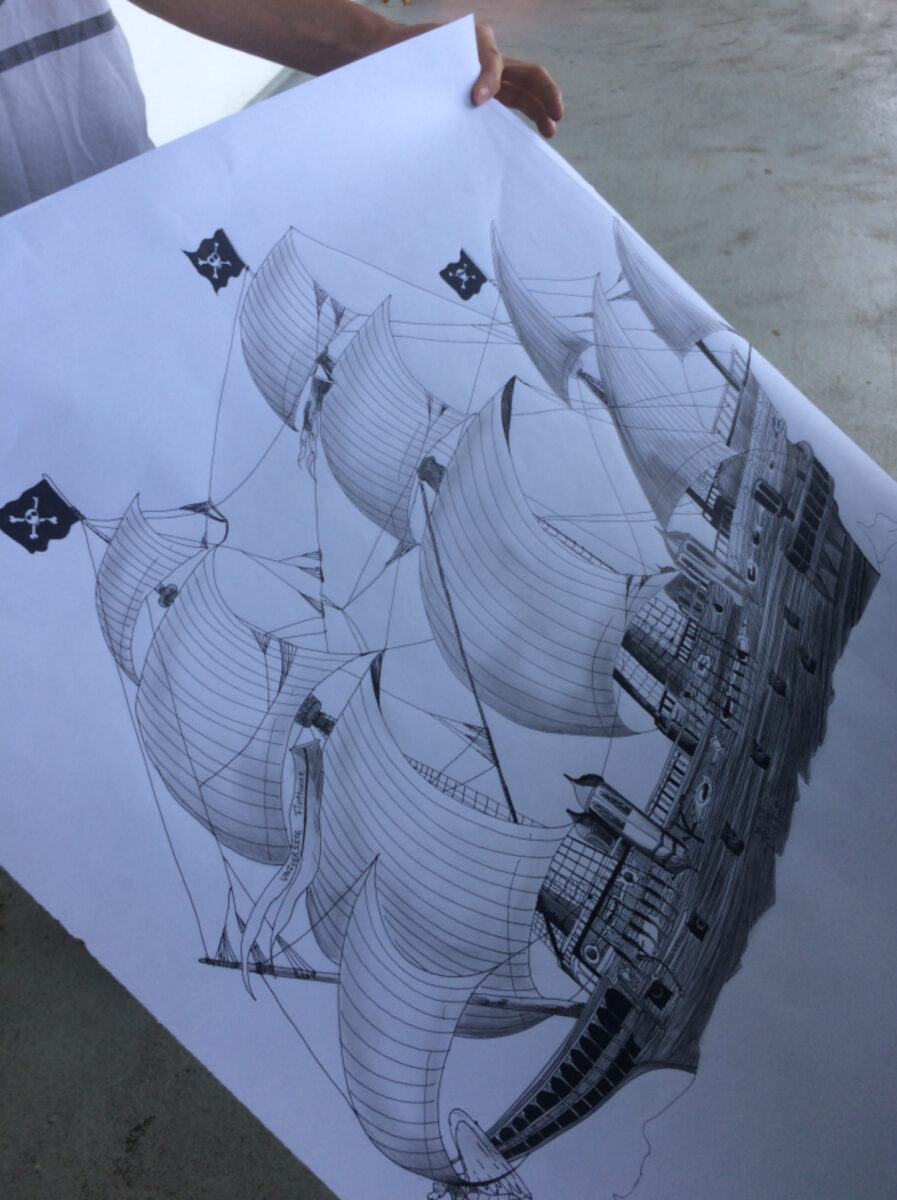Day 20 – 25: a stormy sea

May 9th-14th 2022 | Off the Eastern Cape province, South Africa
Eugénie Dufour, Salomé Pellé, Manon Gibaud and Luis Chomienne

As the first negative contact cases are coming out of their isolation, the sampling stations are resuming their rhythm on the new eddy we are interested in, between Port Elizabeth and Durban. On May 12th, 4 stations were carried out between 8 am and midnight, mobilizing the whole crew. These fixed stations, with diving of the rosette and vertical measurement instruments, alternate with continuous measurements made by the scanFish and the MVP (Moving Verstical Profiler) during transits in close parallel radials, called “radiators”.

During these stations, the work of the students on the zooplankton team has evolved as part of that team is confined. As a result, students are taking more responsibility for the Multinet deployment, which they are now more familiar with, and are happy to be helpful in assisting Sara Tembe with sample filtration and formalin fixation.
The same is true for the acoustic team: trawling has become a daily occurrence and a well-oiled routine has been established. Student changes are now taking place within the shifts themselves. Indeed, these shifts can otherwise be very long and demanding, as record weights of trawls are reached in these coastal areas with their particular hydrodynamics (8 kg at the last news)!





To make the work more pleasant, music is played in the container where the sorting takes place, giving it the appearance of a happy colony. The fashion has extended to the rosette, where the music of the 70’s resounds, giving an idyllic and melancholic atmosphere to the meticulous work done in front of the panorama of the South African coast. No doubt that these moments of peace, far from the world, will remain anchored in the heads of the students, under their well sealed construction helmets.



Sampling in radiators is carried out perpendicular to the coast, with stations of varying depths between 200m at the coast and 2000m offshore. At these depths, small experiments were conducted to highlight the effect of pressure and to keep a small souvenir. Cups and other small polystyrene structures were decorated and attached to the rosette that was lowered to a depth of 2000m. Under this colossal force, the polystyrene contracts and our little works of art are reduced by half!
As for the social life on the boat, some of the students have taken up the challenge of riding 100km on the exercise bikes in the gym, others meet daily in the hold to play ping-pong or badminton… We don’t let ourselves be defeated! Artistic activities are also developing, through drawing, writing (lyrical flights of fancy on the blog), origami, music… and film viewing in the conference room!



The transits from station to station gave us the opportunity to observe megafauna. While the swell makes it difficult to study marine mammals, the breath of a cetacean was nevertheless detected in the distance, 5 km from the boat. A sperm whale! The species is recognizable by its breath, oriented at 45° towards the front left of the individual. Moreover, the frequency of its breathing, less high than that of females or juveniles, suggests that it was an adult male.
A shark was also seen swimming around the boat during the rosette dive… As only the fin could be observed, the species was not directly identified. Nevertheless, thanks to the environmental DNA samples taken by Guillaume Chandelier during this station, it could be determined later. Indeed, this individual has necessarily left a genetic trace of its passage, which will be amplified and compared with the DNA sequences contained in the databases.
While the Agulhas Current has finally been safely exploited as a highway, the seabird team is surprised that the amount of macroplastics, for an area far from rivers and coasts, is unusually high. This is probably due to the floods that hit South Africa and Mozambique recently, which washed a lot of waste into the ocean. Sometimes the Langmuir circulation, converging water created by the wind, forms “lines” of water visible to the naked eye where the waste is collected.
Fortunately, this sad fact does not prevent beautiful encounters: black petrels, with their characteristic flight, low over the water with brutal changes of direction, were seen. These aerobatic performances are quite different from the flight of albatrosses which take advantage of their wingspan to glide gracefully in the wind. Other species were also observed: among them, starlings but also storm-petrels which, unlike albatrosses, are the smallest of the seabirds.
On May 12th, we celebrated Nasreen’s 27th birthday, who is doing her internship with Steven Herbette. It was the occasion for the music group to get together again, with Felipe still on the guitar, Ioannis on the tom-tom, and many singers to perform “Slow Down” by Skip Marley. A moment that brought back some joy to the whole crew!

The conferences continued with Jordan Toullec, on the influence of phytoplankton on the carbon pump, Arthur Blanluet on the impact of FADs (Fish Aggregating Devices) on tuna, Christophe Mocquet, with the work of students from the University of Cote d’Azur on the long-term monitoring of the ecosystem of the Lérins Islands and with Ceiça Chioze on zooplankton communities in the Mozambique Channel. Peter Ryan’s presentation also stirred the hearts of bird fans – but not only – with beautiful images of the species we encountered during our trip and an overview of the major issues affecting seabirds. Summaries of these presentations are being written by the students, and the recordings will be available soon for the benefit of as many people as possible.

While a sweet routine is settling in, it will soon be time to go and retrieve our previous mooring, the Wirewalker, which has been collecting data on its own for the last ten days off Durban. Indeed, we will take advantage of the milder weather conditions to go and retrieve it on Sunday May 16th, before coming back to the eddy where we are now for a last big day of sampling.
Nevertheless, everything remains subject to change: scientists and crew members respond to their own constraints, which are themselves dependent on the weather and the equipment. If there is one thing to remember about this trip, it is how frequent the changes of plans are, but that always solutions are found to allow the best compromise. It is also impressive to see the adaptability of all the members of the boat to allow the good functioning of this micro-nation!

 Attention, vous utilisez un navigateur peu sûr !
Attention, vous utilisez un navigateur peu sûr !